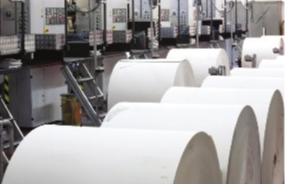Rust to Tech, Part II
- Published: December 20, 2021
By Susan Stansbury, Contributing Writer
This is Part II in a 5-part series. It began with a look at the rust belt image, concentrating on mills making substrates and related converting. Part II is a snapshot of converting examples with associated suppliers and technologies. With the reminder that converting operations add value to roll goods substrates, here are some of the elements. Additionally, it’s notable that converting, from start to finished product, often involves several steps at one or multiple companies.
Slitting & Winding
 This would seem to be the most basic, simple aspect of converting. However, there is a range of capabilities with increasing precision among converters. Some companies can convert extra-wide mill rolls; some cut unusually small ones; diameters provided range from jumbo to tiny—all depending on customer requirements. Some converters who slit and wind rolls combine this step with others such as multiple layering or moving the material directly into other transformations such as flexo printing, coating and laminating. Improved precision in slitting and winding cuts waste and increases productivity.
This would seem to be the most basic, simple aspect of converting. However, there is a range of capabilities with increasing precision among converters. Some companies can convert extra-wide mill rolls; some cut unusually small ones; diameters provided range from jumbo to tiny—all depending on customer requirements. Some converters who slit and wind rolls combine this step with others such as multiple layering or moving the material directly into other transformations such as flexo printing, coating and laminating. Improved precision in slitting and winding cuts waste and increases productivity.
Throughout the converting processing world, there is increased automation for quality, reliability and relief when it’s difficult to recruit workers. “Automation and ERP (Enterprise Resource Planning) are among the latest technology focus in converting where tagging and coding every plant location and piece of equipment allows us to scan and track raw materials and finished goods at every step,” says John Michaud, an owner at American Custom Converting (ACC), Green Bay, WI. “It lets know how far along the job is, where waste is occurring and whether we made a profit on that shipment.”
ACC is investing in automated roll handling to increase speed of roll packaging and in small roll rewinding for customer needs of wide (130”) but small diameter (4” – 20” OD’s)/length as little as 20 feet, with/without a core.
Numerous companies support web handling upgrades at converters. Center surface winding specialists include Associated Machine Design; Atlas Converting’s slitter-winder technology supports the packaging industry; Chase Machine and Engineering touts its 3-D modeling for unwinds-rewinds-slitters while integrating ultrasonics, glue dispensing and thermal bonding.
Bringing new technologies to converting, even when retrofitting equipment are companies like Midwest Engineered Systems where they build new and update converting systems. Retrofitted automation systems, integrated motors and controls are the focus of Quad Plus. Modular Web Solutions offers flexibility; Motion Controls Robotics brings the latest automation that connect production to the front office interfacing with ERP solutions.
Drying
The evolution of paper, substrates and converting into higher technologies improve everything from throughput to energy reduction. Processes often use dryer ovens or infrared drying. Today, many have gone from decades-old traditional equipment to technologies such as a fresh new look at infrared drying. According to Dave Wurtz, CEM, a consulting engineer with Greenervation, LLC which is an agent for Compact Engineering, “Compact’s drying solutions include precision design and manufacture of IR lamps that emit IR in a very narrow bandwidth of the IR spectrum, namely in the 1.35-to-2.5-micron range. This precise range of IR penetrates deep into the sheet creating a positive vapor pressure causing rapid drying. In fact, this drying is so rapid that the evaporation causes a cooling effect with the substrate being cooler leaving the dryer than it was before entering, thus protecting often heat sensitive substrates.”
Compact’s dryers remove twice the water per installed KW when compared to traditional IR, using half the energy and needing less real estate on the machine which is often at a premium. Compact dryers are designed around machine speed and width, with modular options. It’s a technology that’s well suited for paper, nonwovens, coating, laminating, flexible packaging, cold seal and other adhesives and flexographic printing.”
Adhesives and Laminates
Part of technology upgrades involves looking at other competing options. For example, Patrick Kellogg of Savare Specialty Adhesives North America explains that switching from water-based adhesives to hot melt in assembly lines cuts waste and has better turnaround times. “There is no drying or cure time,” he says, “and for layered materials, it’s an ideal approach.” Applications also include foam-to-foam bonding, tapes and pressure-sensitive labels.
Companies like Sierra Coating Technologies work with coatings and laminating expertise using paper, poly and nonwovens to produce “Super Material ™”. Mid South Extrusion produces polyethylene films in mono and multi-layered structures for printing and converting. Eight-color printing, plus laminating for roll stock, bags and pouches requires converting complexity by Fredman Bag Company.
Next: Part III will cover some of the latest converting technologies with an emphasis on their associated markets.
About the Author
Susan Stansbury is a converting advocate with extensive experience in the paper, converting, printing and related industries serving in roles including sales and marketing management.












